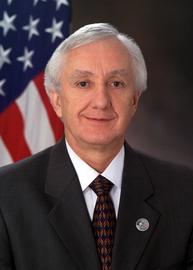Feb
23
Its Time to Start Reprocessing Nuclear Fuel
February 23, 2011 | 5 Comments
Dale Klein, Ph.D., Associate Vice Chancellor for Research at the University of Texas, currently serving as a U.S. Nuclear Regulatory Commission (NRC) Commissioner and former NRC Chairman pointed out again this week the U.S. has an extremely valuable resource in used nuclear fuel.
Klein made his remarks Sunday morning at the American Association for the Advancement of Science’s (AAAS) annual meeting, in Washington, D.C. reminding us that 95 percent of the energy value in a bundle of used nuclear fuel rods remains available to be re-used. That’s 19 times the energy already used over the past 50 years from nuclear power stations. Those power stations have provided about 20% of the electrical power used in the U.S over about 30 years.
It’s a huge resource. This writer hasn’t seen the math on the size of an equivalent pile of coal for the unused nuclear fuel, but it would a massive mountain, and an even more impressive balloon of CO2 when burned.
Klein serves as an associate director at UT Austin’s Energy Institute where the research is under way for treatment of spent fuel from nuclear reactors to extract the energy contained in the fuel, and to reduce the toxicity and heat load by two orders of magnitude.
In an understatement Klein points out, “The once-through nuclear fuel cycle, which is our practice in the U.S., is an enormous waste of potential energy.”
Keep in mind; the U.S. was the gold standard in nuclear power for energy production, a lead that’s slipped away taking research jobs, construction jobs, operating jobs, maintenance jobs, and dirt-cheap electric rates. You’re paying lots more every month as the spent fuel resource malingers in pools of water.
Meanwhile Klein points out other countries, including France, Japan, the United Kingdom, Russia, India, and China have dedicated significant resources toward their reprocessing programs, producing all those jobs economic benefits and export opportunities. This writer hasn’t seen any numbers on the economic growth lost for entertaining nuclear fears. It’s surely in the hundreds of billions of dollar, and growing. The country list above also shows how difficult it’s going to be to even get a small market piece in the future.
The pumping of hysteria, political correctness, into an ill informed American population has cost the economy dearly now and everyone will pay dearly into the future. Those who are old enough to remember the Three Mile Island episode, which did not blow up, meltdown, explode, or release a cloud of radiation will remember the intense “news coverage” that kept the nation and much of the world on the edge of its seat for days.
While the Three Mile Island episode stands as a nuclear event, it’s really the foremost example of news misleading the public, followed with amplification by pundits, politicians and special interests leading to a misinformed public. We’re paying for it with every utility bill to this day – and will for years to come.
The other major issue critics cite would be the potential for nuclear weapons proliferation as the biggest reason to oppose recycling. Klein points out such concerns are largely unfounded, “While it is true that the plutonium in recycled nuclear fuel is fissionable, no country in the world has ever made a nuclear weapon out of low-grade plutonium from recycled high burn-up nuclear fuel. It just doesn’t work for a strategic or a tactical nuclear weapon.”
The fact is the reverse, as Klein states reprocessing not only recovers significant energy value from spent fuel, it substantially reduces the volume and radiotoxicity of high-level nuclear waste. Its actually a simple thing – the energy of radioactivity can be turned into power – the more the fuel is used, the less dangerous it becomes.
This writer keeps looking for a credible value, which can be lost as well as gained from nuclear fuel. Its going to a gigantic number in economic activity, reduced risk and expense in handling the used fuel already on hand, and should guarantee that more electrification take over from fuels.
Brian Wang points out that there should be a near complete change in the U.S. in regulatory outlook such that certification would not be done at the NRC. The NRC has not ever approved a new reactor in 36 years. Its unnerving to have such a bureaucracy in charge of such a huge national resource with nearly two generations of positive inactivity and a history replete with negative activity.
Sometimes the thought becomes, “It’s a wonder the lights come on at all.”
Keep an eye out for those economic numbers that are needed for the case to get on with using the nuclear resources at hand. When you see them, post a comment or send an email, the numbers will get posted here.
Comments
5 Comments so far



This would help alleviate the coming shortage of Uranium brought about by all the new reactors coming on line in other countries.
We have to do something with it. Why not recycle it?
[…] Today more than 70% of power Additionally you can check out: https://newenergyandfuel.com/http:/newenergyandfuel/com/2011/02/23/its-time-to-start-reprocessing-nuc… […]
Admiring the dedication you put into your website and detailed information you present. It’s nice to come across a blog every once in a while that isn’t the same outdated rehashed information. Wonderful read! I’ve saved your site and I’m adding your RSS feeds to my Google account.
Thank you so much for useful information. I’ll visit your site more often.
Hello to all, how is all, I think every one is getting more from this website,
and your views are good designed for new users.